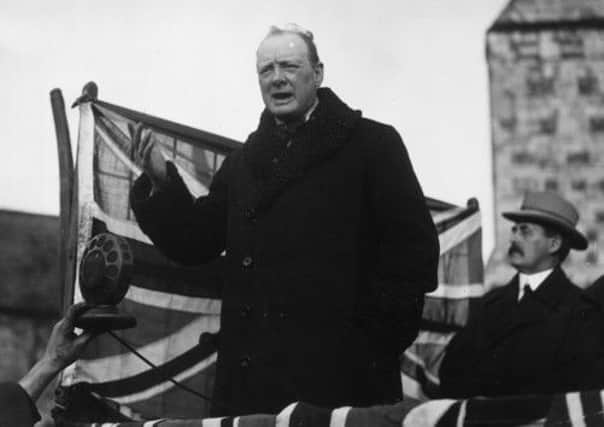Book review: Churchill’s Bomb by Graham Farmelo


CHURCHILL’S BOMB
Graham Farmelo
Faber, 576pp, £25
One would hardly think that the world needs another book on Churchill, or on the nuclear bomb, but Costa biography award-winner Graham Farmelo presents us with a story and an analysis which are so fresh and compelling that we might feel we have come to both subjects for the first time.
We first meet Churchill as a chirpy 25-year-old, enjoying the club-and party-going company of HG Wells. Churchill avidly read everything Wells wrote, and was particularly impressed with the non-fiction (such as Anticipations) as well as the fiction (The World Set Free) which dealt with the future of warfare and foresaw the impact of an “atomic bomb”. Influenced by this, and by the commentary of his (initially) informal scientific adviser Frederick Lindemann, in 1924 Churchill wrote “Shall We All Commit Suicide?” about the potential devastation a nuclear bomb could cause – even though he always aimed for Britain to have one.
Advertisement
Hide AdThe problem, Farmelo shows, was that Churchill failed to understand the complex interrelation between scientific thinking, scientific experiment and open exchange of ideas needed to make discoveries and turn them into practical applications. He also had no patience with most scientists, whose training disinclined them to give him firm and categorical answers.
The exception was Lindemann – whom Churchill nicknamed “the Prof”– whose social climbing offended many scientists (a joke at the time was ‘Why is Lindemann like a coastal steamer?’ ‘Because he goes from peer to peer.’) But it was Lindemann whom Churchill latched onto, bypassing the likes of Ernest Rutherford and his team of scientists who had discovered the neutron and split the atom.
Churchill was of course utterly focused on winning the war against Hitler, but when the US entered it he missed his chance to share the expertise of his nuclear physicists with the Americans. Although it was not his wartime priority, he wanted to develop a British bomb, despite the misgivings of his General Staff and his physicists, not least about where, in a war-torn world, there might be a suitable site to test it.
Ousted by the electorate in 1945, Churchill began his second premiership in 1951 after Britain had acquired its nuclear capability during Attlee’s government, but his powers were waning and he failed to see the need to keep up with ways of delivering the nuclear bomb. He was also unsympathetic to the way world politics had changed, and his attempts to pursue disarmament were locked in the mindset of the first half of the twentieth century.
Given the barely imaginable horrors of nuclear warfare (the first H-bomb the Americans tested in 1952 had an explosive power of more than twice the explosives used in the Second World War) and errors of political decision- making over a period of more than 30 years, Graham Farmelo’s thesis is scrupulously researched and superbly written.
Churchill’s Bomb is set out in four long sections, each section divided into chapters of 12 or so pages devoted to a precise time frame. (It’s the structure that Farmelo used for The Strangest Man, his award-winning biography of physicist Paul Dirac.) We all know what’s going to happen in August 1945, and that the Second World War will be followed by the Cold War and a nuclear arms race. Nevertheless, Farmelo’s style keeps us in suspense, and his book really is a page- turner. It is also a compendium of mini-biographies of all the significant players in this gargantuan story, each deftly and compassionately told, with touches of apt simile, wit and poignancy. Professor Rutherford had “a bay window of a belly…and a cigarette … hanging from his bottom lip”. Professor Lindemann’s vegetarianism included a partiality for scrambled eggs (whites only; no yolks). President Roosevelt’s first nuclear bomb project manager “Van” Bush had two ways with those who disagreed with him. If they didn’t toe the line after a convivial dinner, they “risked being skunk-sprayed with profanities”.When Rudolf Peierls (one of first two physicists to establish that the nuclear bomb was possible) and his wife Genia discovered that Klaus Fuchs, their friend and lodger, had betrayed all his nuclear secrets to the Soviets they were broken people. Farmelo quotes from their barely legible tear-stained letter to Fuchs in Brixton Prison.
Advertisement
Hide AdFarmelo also gives other glimpses of how the immensity of their responsibilities affected the scientists. In the spring of 1941, Professor James Chadwick knew that not only was a nuclear bomb possible, it was inevitable. Shortly before his death in 1974, Chadwick admitted that when he knew this secret he had to start taking sleeping pills. “I’ve never stopped,” he said. And when William Penney, who had headed the British nuclear team in the US, was asked off the record about superpower stockpiling of nuclear weapons in the 1950s he said: “They were mad, mad, MAD!”
Churchill’s Bomb is a powerful and moving contribution to literature about the 20th century and to biographical and historical writing, so it is worrying to hear that Graham Farmelo is on record as saying this is to be his last foray into this genre and that he is to return to science writing. We must all hope that this is not a complete renunciation and that there will be further opportunities for readers to appreciate his unique gifts.